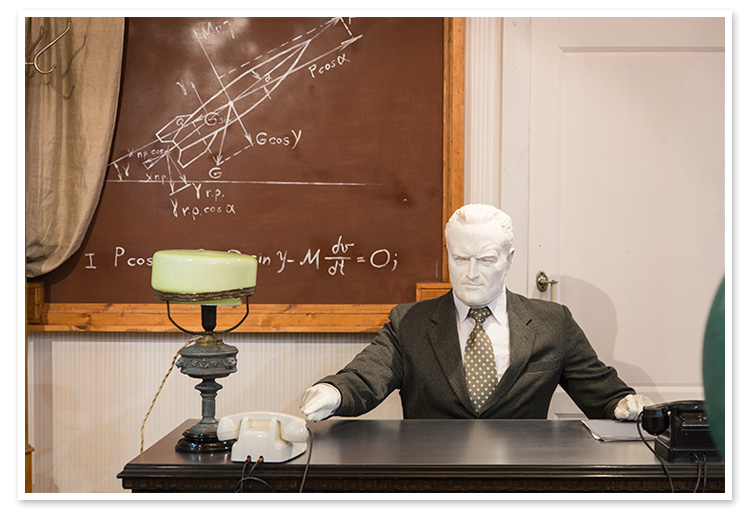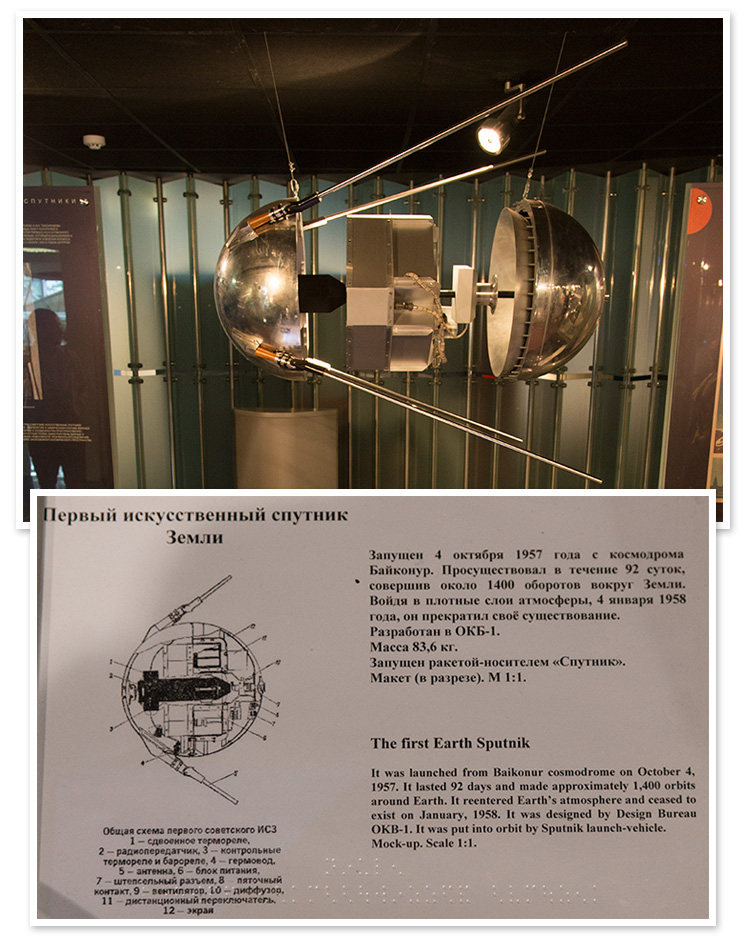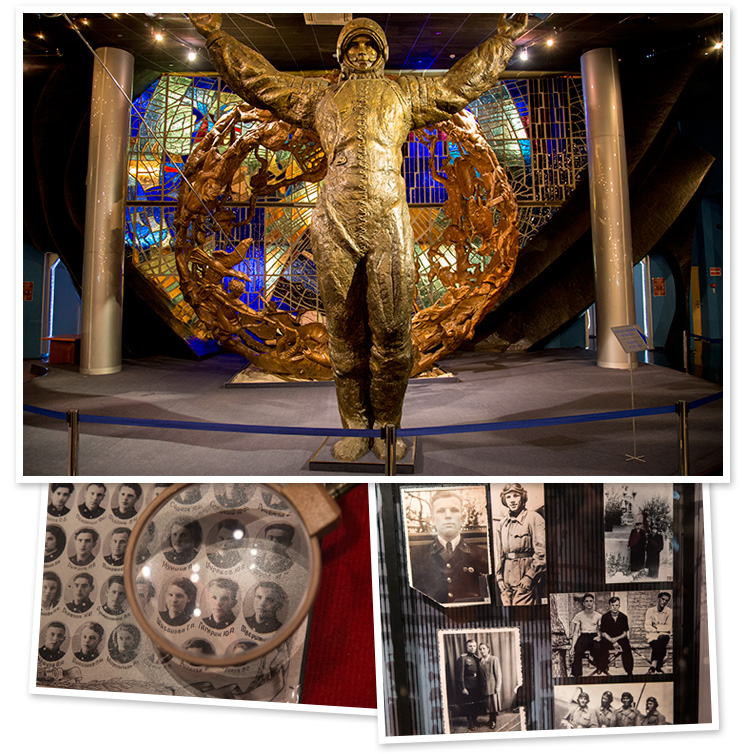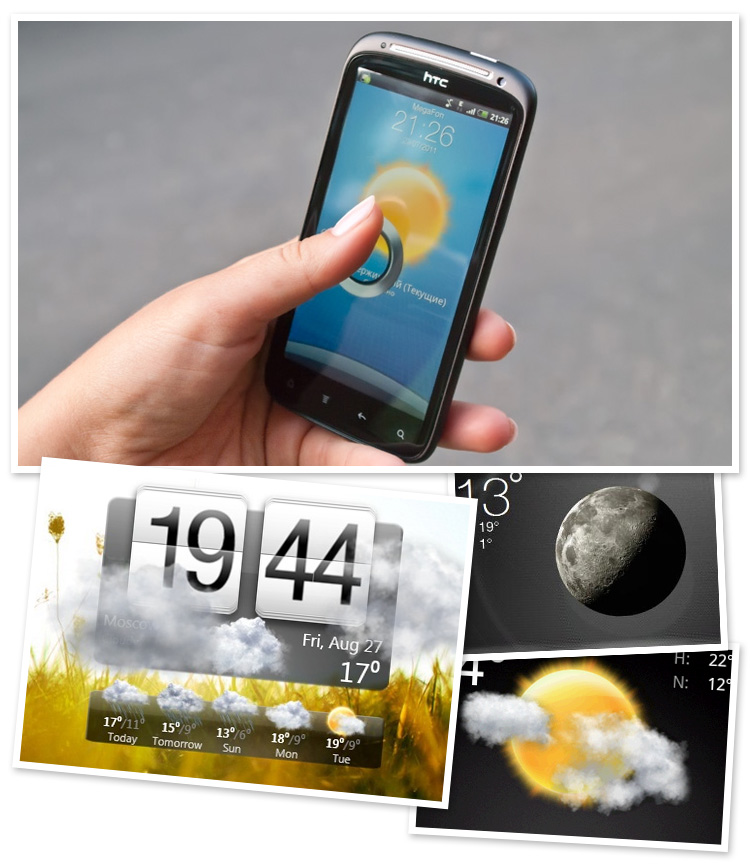Cosmonautics development
Perhaps the development of astronautics has its origins in science fiction: people have always wanted to fly - not only in the air, but also across the vast expanses of space. As soon as people were convinced that the earth's axis was not capable of hitting the celestial dome and piercing it, the most inquisitive minds began to wonder: what is there, higher? It is in the literature that you can find many references to various ways of separation from the Earth: not only natural phenomena such as a hurricane, but also quite specific technical means - balloons, heavy-duty guns, carpets, airplanes, rockets and other costumes-superjet. Although the first more or less realistic description of the flight means is the myth of Icarus and Daedalus.

Gradually, from the flight of imitative (that is, flight based on the imitation of birds), mankind proceeded to flight based on mathematics, logic, and the laws of physics. The significant work of the aviators in the person of the Wright brothers, Albert Santos-Dumont, Glenn Hammond Curtis only strengthened the man’s belief that flying is possible, and sooner or later the cold twinkling points in the sky will become closer, and then ...

')
The first mention of astronautics as a science began in the 30s of the twentieth century. The term "cosmonautics" itself appeared in the title of Ari Abramovich Sternfeld's scientific work "Introduction to cosmonautics". At home, in Poland, the scientific community was not interested in his works, but they showed interest in Russia, where the author subsequently moved. Later, other theoretical works and even the first experiments appeared. As a science, cosmonautics was formed only in the middle of the 20th century. And no matter what anyone said, our Motherland opened the way to space.
Konstantin E. Tsiolkovsky is considered the founder of cosmonautics. Once he said: “ At first, inevitably they go: thought, fantasy, fairy tale, and an exact calculation is being followed behind them ”. Later, in 1883, he suggested the possibility of using jet propulsion for the creation of interplanetary aircraft. But it would be wrong not to mention such a person as Nikolai Ivanovich Kibalchich, who put forward the very idea of the possibility of building a rocket aircraft.

In 1903, Tsiolkovsky publishes his scientific work “The Study of World Spaces with Jet Instruments”, where he comes to the conclusion that liquid-fuel rockets can lead a man into space. Tsiolkovsky’s calculations have shown that flying into space is a matter for the near future.
A little later, the works of foreign rocket builders were added to the works of Tsiolkovsky: in the early 1920s, the German scientist Herman Obert also outlined the principles of interplanetary flight. In the mid-20s, American Robert Goddard began to develop and build a successful prototype of a liquid-propellant rocket engine.

The works of Tsiolkovsky, Obert and Goddard became a kind of foundation on which rocket science and, later, all cosmonautics grew. The main research activities were conducted in three countries: in Germany, the USA and the USSR. In the Soviet Union, research work was conducted by the Group for the Study of the Jet Propulsion (Moscow) and the Gas-Dynamic Laboratory (Leningrad). On the basis of them in the 30s a Rocket Institute (RNII) was created.
Such specialists as Johannes Winkler and Werner von Braun worked in Germany. Their research in the field of jet engines gave a powerful impetus to rocket production after the Second World War. Winkler did not live long, and von Braun moved to the United States and for a long time was the real father of the United States space program.
In Russia, Tsiolkovsky’s case was continued by another great Russian scientist, Sergei Pavlovich Korolev.

It was he who created the group studying the jet propulsion and it was there that the first domestic missiles, GIRD 9 and 10, were created and successfully launched.

You can write so much about technology, people, rockets, development of engines and materials, problems solved and the path made, so the article will be longer than the distance from Earth to Mars, so we omit some details and move on to the most interesting part - practical cosmonautics.
On October 4, 1957, mankind made the first successful launch of a space satellite. For the first time, the creation of human hands penetrated beyond the limits of the earth's atmosphere. On this day, the whole world was amazed at the success of Soviet science and technology.

What was available to mankind in 1957 from computing? Well, it is worth noting that in the 1950s the first computers were created in the USSR, and only in 1957 the first computer based on transistors (and not radio tubes) appeared in the USA. There was no talk of any gigabytes, mega-, or even kiloflops. The typical computer of that time occupied a couple of rooms and gave out “only” a couple of thousand operations per second (the Strela computer ).
The progress of the space industry was colossal. In just a few years, the accuracy of launch vehicle control systems and spacecraft has grown so much that, from an error of 20–30 km when put into orbit in 1958, a man took a step in landing the vehicle on the Moon at a five-kilometer radius by the mid-60s.
More - more: in 1965 it became possible to transfer photographs from Mars to Earth (and this distance is more than 200,000,000 kilometers), and already in 1980 - from Saturn (distance - 1,500,000,000 kilometers!). Speaking of the Earth - now a set of technologies allows to obtain relevant, reliable and detailed information about natural resources and the state of the environment.
Together with the exploration of space, the development of all “passing directions” - space communications, television broadcasting, relaying, navigation, and so on. Satellite communication systems began to cover almost the whole world, making it possible for two-way operational communication with any subscribers. Now there is a satellite navigator in any car (even in a toy), and then the existence of such a thing seemed something incredible.
In the second half of the 20th century, the era of manned flights began. In the 1960s – 1970s, Soviet cosmonauts demonstrated a person’s ability to work outside a spacecraft, and from the 1980s – 1990s people began to live and work in weightless conditions for almost years. It is clear that each such journey was accompanied by a variety of various experiments - technical, astronomical, and so on.

A great contribution to the development of advanced technologies was made by the design, creation and use of complex space systems. Automatic spacecraft sent to space (including to other planets), in fact, are robots that are controlled from the earth using radio commands. The need to create reliable systems for solving such problems has led to a more complete understanding of the problem of analyzing and synthesizing complex technical systems. Now such systems are used both in space research and in many other areas of human activity.

Take, for example, the weather - the usual thing, in mobile appstores for its output, there are dozens and even hundreds of applications. But where with enviable periodicity to take pictures of the cloud cover of the Earth, but not from the Earth itself? ;) Exactly. Now, almost all countries of the world use weather data for weather information.
Not as fantastic as the words “space forge” sound 30-40 years ago. In conditions of weightlessness, it is possible to organize such production, which is simply not feasible (or not profitable) to unfold in the conditions of earth gravity. For example, the state of weightlessness can be used to obtain ultrathin crystals of semiconductor compounds. Such crystals will find application in the electronics industry to create a new class of semiconductor devices.

Pictures from my article on processor production
In the absence of gravity, freely floating liquid metal and other materials are easily deformed by weak magnetic fields. This opens the way for the production of ingots of any predetermined shape without their crystallization in molds, as is done on Earth. The peculiarity of such ingots is the almost complete absence of internal stresses and high purity.
At the moment, there are more than a dozen space centers with unique ground-based automated complexes, as well as test stations and all sorts of complex means of preparing for launching spacecraft and launch vehicles around the world. In Russia, the Baikonur and Plesetsk cosmodromes are well known all over the world, and, well, Svobodny, from which experimental launches are periodically carried out.

In general ... now so much is being done in space - sometimes they will tell something, you won’t believe :)
Moscow, metro VDNKh - from which side you look, and the monument "Conquerors of Space" can not be overlooked.

But not many people know that in the basement part of the 110-meter monument there is an interesting cosmonautics museum, where you can learn in detail about the history of science: there you can find Belka with Strelka, Gagarin with Tereshkova, and space suits with moon rovers ...

The museum is located (made in miniature) Flight Control Center, where you can observe the International Space Station in real time and carry out negotiations with the crew. Interactive cabin "Buran" with mobility system and panoramic stereo image. Interactive cognitive and teaching class, made in the form of cabins. Interactive exhibits are placed in special zones, which include simulators identical to simulators at the Yury Gagarin Cosmonaut Training Center: simulator of the rendezvous and docking transport spacecraft, virtual simulator of the international space station, simulator of a search helicopter pilot. And, of course, where without any film and photographic materials, archival documents, personal belongings of the space industry workers, items of numismatics, philately, philocarty and phaleristics, works of fine and decorative arts ...
At the time of writing this article, it was nice to refresh history, but now everything is somehow not so optimistic, perhaps - most recently we were superbysons and leaders of outer space, and now we cannot even put a satellite into orbit ... We live in a very interesting time - if before the slightest technical advances had been going on for years and decades, now technologies are developing much more rapidly. Take the same Internet - the times when the WAP-sites on two-color display phones are barely opened are not yet forgotten, but now we can do anything on the phone (in which there is no pixel) anything. ANYTHING. Perhaps the best conclusion of this article will be the famous performance of the American comedian Louis C. K, “Everything is excellent, but everyone is unhappy”:
If not playing with YouTube
It is clear that the entire history of cosmonautics in one article does not tell ... but, thanks to these rockets and satellites, you now have the Internet - on the same YouTube there are a huge number of informative videos about this interesting science. Allocate a couple of hours of time somehow, look - this is VERY interesting. And, of course, subscribe to the author Zelenyikot - our main cosmonaut on the site :)
The remaining posts of our "historical" special project :
» Visiting the switch
" Hello, is this an intercom?
» Anatomy of a mast connection
» The history of mail development
» About Morse Code
» The history of the telegraph
» Thanks to radiophysics
» The history of the appearance of the radio
LTE in Kazan. Universiade
» LTE in St. Petersburg
» LTE in Yekaterinburg
» Overview of LTE Devices
! important: The article does not pretend to the completeness and accuracy of all data.

Gradually, from the flight of imitative (that is, flight based on the imitation of birds), mankind proceeded to flight based on mathematics, logic, and the laws of physics. The significant work of the aviators in the person of the Wright brothers, Albert Santos-Dumont, Glenn Hammond Curtis only strengthened the man’s belief that flying is possible, and sooner or later the cold twinkling points in the sky will become closer, and then ...

')
The first mention of astronautics as a science began in the 30s of the twentieth century. The term "cosmonautics" itself appeared in the title of Ari Abramovich Sternfeld's scientific work "Introduction to cosmonautics". At home, in Poland, the scientific community was not interested in his works, but they showed interest in Russia, where the author subsequently moved. Later, other theoretical works and even the first experiments appeared. As a science, cosmonautics was formed only in the middle of the 20th century. And no matter what anyone said, our Motherland opened the way to space.
Konstantin E. Tsiolkovsky is considered the founder of cosmonautics. Once he said: “ At first, inevitably they go: thought, fantasy, fairy tale, and an exact calculation is being followed behind them ”. Later, in 1883, he suggested the possibility of using jet propulsion for the creation of interplanetary aircraft. But it would be wrong not to mention such a person as Nikolai Ivanovich Kibalchich, who put forward the very idea of the possibility of building a rocket aircraft.

In 1903, Tsiolkovsky publishes his scientific work “The Study of World Spaces with Jet Instruments”, where he comes to the conclusion that liquid-fuel rockets can lead a man into space. Tsiolkovsky’s calculations have shown that flying into space is a matter for the near future.
A little later, the works of foreign rocket builders were added to the works of Tsiolkovsky: in the early 1920s, the German scientist Herman Obert also outlined the principles of interplanetary flight. In the mid-20s, American Robert Goddard began to develop and build a successful prototype of a liquid-propellant rocket engine.

The works of Tsiolkovsky, Obert and Goddard became a kind of foundation on which rocket science and, later, all cosmonautics grew. The main research activities were conducted in three countries: in Germany, the USA and the USSR. In the Soviet Union, research work was conducted by the Group for the Study of the Jet Propulsion (Moscow) and the Gas-Dynamic Laboratory (Leningrad). On the basis of them in the 30s a Rocket Institute (RNII) was created.
Such specialists as Johannes Winkler and Werner von Braun worked in Germany. Their research in the field of jet engines gave a powerful impetus to rocket production after the Second World War. Winkler did not live long, and von Braun moved to the United States and for a long time was the real father of the United States space program.
In Russia, Tsiolkovsky’s case was continued by another great Russian scientist, Sergei Pavlovich Korolev.

It was he who created the group studying the jet propulsion and it was there that the first domestic missiles, GIRD 9 and 10, were created and successfully launched.

You can write so much about technology, people, rockets, development of engines and materials, problems solved and the path made, so the article will be longer than the distance from Earth to Mars, so we omit some details and move on to the most interesting part - practical cosmonautics.
On October 4, 1957, mankind made the first successful launch of a space satellite. For the first time, the creation of human hands penetrated beyond the limits of the earth's atmosphere. On this day, the whole world was amazed at the success of Soviet science and technology.

What was available to mankind in 1957 from computing? Well, it is worth noting that in the 1950s the first computers were created in the USSR, and only in 1957 the first computer based on transistors (and not radio tubes) appeared in the USA. There was no talk of any gigabytes, mega-, or even kiloflops. The typical computer of that time occupied a couple of rooms and gave out “only” a couple of thousand operations per second (the Strela computer ).
The progress of the space industry was colossal. In just a few years, the accuracy of launch vehicle control systems and spacecraft has grown so much that, from an error of 20–30 km when put into orbit in 1958, a man took a step in landing the vehicle on the Moon at a five-kilometer radius by the mid-60s.
More - more: in 1965 it became possible to transfer photographs from Mars to Earth (and this distance is more than 200,000,000 kilometers), and already in 1980 - from Saturn (distance - 1,500,000,000 kilometers!). Speaking of the Earth - now a set of technologies allows to obtain relevant, reliable and detailed information about natural resources and the state of the environment.
Together with the exploration of space, the development of all “passing directions” - space communications, television broadcasting, relaying, navigation, and so on. Satellite communication systems began to cover almost the whole world, making it possible for two-way operational communication with any subscribers. Now there is a satellite navigator in any car (even in a toy), and then the existence of such a thing seemed something incredible.
In the second half of the 20th century, the era of manned flights began. In the 1960s – 1970s, Soviet cosmonauts demonstrated a person’s ability to work outside a spacecraft, and from the 1980s – 1990s people began to live and work in weightless conditions for almost years. It is clear that each such journey was accompanied by a variety of various experiments - technical, astronomical, and so on.

A great contribution to the development of advanced technologies was made by the design, creation and use of complex space systems. Automatic spacecraft sent to space (including to other planets), in fact, are robots that are controlled from the earth using radio commands. The need to create reliable systems for solving such problems has led to a more complete understanding of the problem of analyzing and synthesizing complex technical systems. Now such systems are used both in space research and in many other areas of human activity.

Take, for example, the weather - the usual thing, in mobile appstores for its output, there are dozens and even hundreds of applications. But where with enviable periodicity to take pictures of the cloud cover of the Earth, but not from the Earth itself? ;) Exactly. Now, almost all countries of the world use weather data for weather information.
| It is interesting. Space satellites that have served their time are sent to the “cemetery” - a special “burial orbit” dedicated to this purpose. It is located 200 km above the geostationary orbit. According to NASA estimates, the number of satellite satellites exceeds 8,000. |

Pictures from my article on processor production
In the absence of gravity, freely floating liquid metal and other materials are easily deformed by weak magnetic fields. This opens the way for the production of ingots of any predetermined shape without their crystallization in molds, as is done on Earth. The peculiarity of such ingots is the almost complete absence of internal stresses and high purity.
| Interesting posts from Habr: habrahabr.ru/post/170865 + habrahabr.ru/post/188286 |

In general ... now so much is being done in space - sometimes they will tell something, you won’t believe :)
Get bogged down!
Moscow, metro VDNKh - from which side you look, and the monument "Conquerors of Space" can not be overlooked.

But not many people know that in the basement part of the 110-meter monument there is an interesting cosmonautics museum, where you can learn in detail about the history of science: there you can find Belka with Strelka, Gagarin with Tereshkova, and space suits with moon rovers ...

The museum is located (made in miniature) Flight Control Center, where you can observe the International Space Station in real time and carry out negotiations with the crew. Interactive cabin "Buran" with mobility system and panoramic stereo image. Interactive cognitive and teaching class, made in the form of cabins. Interactive exhibits are placed in special zones, which include simulators identical to simulators at the Yury Gagarin Cosmonaut Training Center: simulator of the rendezvous and docking transport spacecraft, virtual simulator of the international space station, simulator of a search helicopter pilot. And, of course, where without any film and photographic materials, archival documents, personal belongings of the space industry workers, items of numismatics, philately, philocarty and phaleristics, works of fine and decorative arts ...
Harsh reality
At the time of writing this article, it was nice to refresh history, but now everything is somehow not so optimistic, perhaps - most recently we were superbysons and leaders of outer space, and now we cannot even put a satellite into orbit ... We live in a very interesting time - if before the slightest technical advances had been going on for years and decades, now technologies are developing much more rapidly. Take the same Internet - the times when the WAP-sites on two-color display phones are barely opened are not yet forgotten, but now we can do anything on the phone (in which there is no pixel) anything. ANYTHING. Perhaps the best conclusion of this article will be the famous performance of the American comedian Louis C. K, “Everything is excellent, but everyone is unhappy”:
If not playing with YouTube
It is clear that the entire history of cosmonautics in one article does not tell ... but, thanks to these rockets and satellites, you now have the Internet - on the same YouTube there are a huge number of informative videos about this interesting science. Allocate a couple of hours of time somehow, look - this is VERY interesting. And, of course, subscribe to the author Zelenyikot - our main cosmonaut on the site :)
The remaining posts of our "historical" special project :
» Visiting the switch
" Hello, is this an intercom?
» Anatomy of a mast connection
» The history of mail development
» About Morse Code
» The history of the telegraph
» Thanks to radiophysics
» The history of the appearance of the radio
LTE in Kazan. Universiade
» LTE in St. Petersburg
» LTE in Yekaterinburg
» Overview of LTE Devices
! important: The article does not pretend to the completeness and accuracy of all data.
Source: https://habr.com/ru/post/195226/
All Articles